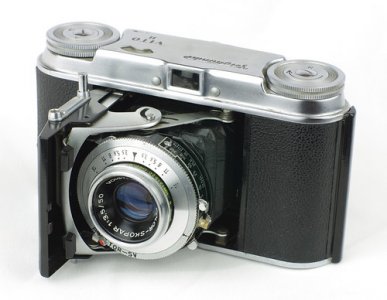Jason Schneider
the Camera Collector
Compact, Fast Lensed 35mm Cameras, Part 1
Pocket-sized scale-focusing 35s: Maxi performance in Mini packages!
By Jason Schneider
For some strange reason, sellers of vintage 35mm cameras often list scale-focusing models as “rangefinder cameras” which they assuredly are not. Although many would benefit by mounting a separate, uncoupled rangefinder in their accessory shoes (an inconvenient solution employed by many Leica I (Model A) shooters back in the day) scale focusing 35s are a separate species with a fascinating history of their own. Indeed, the best ones are superb, pocketable shooters even though few full-frame models are fitted with lenses faster than f/2.8.
In the beginning, all 35mm still picture cameras were scale focusing, and most of those made prior to the release of the Leica I (Model A) in 1925 were ponderous contraptions with large film capacities, many vertically configured like the cine cameras of the day, and all used the standard 18x24mm cine format. One early exception was the New York-made Simplex of 1914, a beautifully made but clunky machine with a horizontal form factor that gave a choice of 18x24mm and 24x36mm formats and sold for a then staggering price of $65. The genius of Oskar Barnack’s Leica was that it was an elegant, pocketable, “precision miniature” with a collapsible lens that automatically stopped at the next exposure, cocked the focal plane shutter, and advanced the film counter one notch as you turned the film-wind knob— pedestrian by today’s standards, but remarkably advanced a century ago. Even more important, the Leica I (Model A) established the basic form factor for practically every compact 35mm camera that succeeded it, up to and including all the compact scale-focusing 35s featured in Part 1 of this article. So, while the Leica was neither the first 35mm camera nor the first with the standard 24x36mm format it was the camera that put 35mm photography on the map.
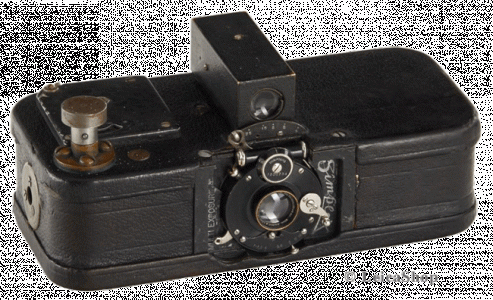
Simplex camera of 1914 gave a choice of 18 x 24mm and 24 x 36mm formats. It was made in Long Island City, NY. Image courtesy Leica Shop.
From about 1925 to 1945, compact, scale-focusing 35mm cameras proliferated to meet the demands of photographers who wanted sophisticated compact cameras with full manual controls that were more affordable than a Leica or a Contax. Examples include the following folding 35s: the Kodak Retina I (produced in many versions by Kodak AG, Stuttgart, formerly Nagel Werk), the Welti, by Welta of Dresden (available in a variety of lens-shutter combos), the Voigtlander Vito (an elegant folder that debuted in 1936), the Beirette by Beier (1939) and the Certo Durata (rare scale focusing cousin of the better-known Certo Dollina rangefinder 35). Non-folding models include the Altix I (by EHOI-Altissa), the Photavit (aka Boltavit) by Bolta-Werk (1936), the collapsible-lens Edinex (later sold as the Adox Adrette) by Gebr. Wirgin of Wiesbaden, the rough and ready Reyna (first produced by Cornu of France in 1941 under German occupation!) and the lovably Spartan Kodak 35 of 1938, Kodak’s first U.S- made 35, produced in anticipation of the cessation of German imports during WWII.
Most of the above-mentioned cameras are fitted with 50mm f/3.5 Zeiss Tessar, Schneider Xenar, or Kodak Ektar lenses, all sharp, high quality 4-element, 3-group designs. If you want something a bit faster you must settle for a triplet lens such as a 50mm f/2.9 Meyer Trioplan (pretty good), or a 50mm f/2.9 Schneder Radionar (OK, but not as good as the Trioplan). There was one glorious exception we’ll get to shortly.
My favorite scale focusing compact 35s.
The Kodak 35: Bearing a slight resemblance to the German Wirgin Edinex, this minimalist charmer features a precision molded black Bakelite body with satin-chromed top and base plates, and a collapsible frame viewfinder centrally mounted on top. The back/baseplate unit slides easily off for easy film loading and is secured by a centrally located wing key. Turning the key also slackens the spring tension of the chromed steel film pressure plate, an unusual feature probably intended to facilitate reassembling the camera rather than to preventing film scratching, which would have been a novel feature. The Kodak 35 has a manually reset automatic frame counter, a chromed wind-on release button, and a rigidly mounted front-cell-focusing Kodak lens set in a Kodak inter-lens leaf shutter. The shutter is cocked by a gear coupled to the sprocket shaft that turns as the film is advanced, so the shutter can’t normally be cocked unless there’s film in the camera. An automatic mechanism locks the film wind knob when the next frame is in shooting position and it’s released by depressing the wind-on release button before you advance to the next exposure This simple system prevents double exposures, but not blank frames since nothing prevents you from pressing the button again and advancing the film. However, a red indicator in a slot atop the shutter housing indicates the camera has been wound. The shutter release itself, a rearward-pointing pin attached to the shutter release lever, is located at about 10 o'clock on the shutter housing, and it’s protected from accidental release by a small cover extending over it.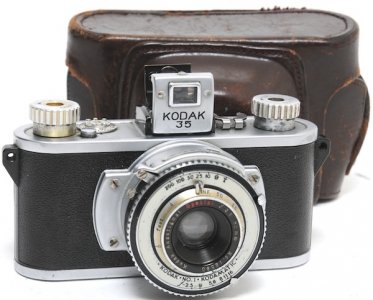
Kodak 35 with 50mm f/3.5 Kodak Anastigmat Special lens (a front-cell-focusing Tessar type). It's a fun camera that performs remarkably well.
The Kodak 35 is a fun camera to shoot with, and a surprisingly adept picture taker, especially if you opt for one with the excellent 4-element Kodak Anastigmat Special or Kodak Anastar lens: Recommended models: Kodak 35 of 1938–1949 with 50mm f/3.5 Kodak Anastigmat Special lens in Kodamatic shutter and Kodak 35 of 1947–1948 with 51mm f/3.5 Kodak Anastigmat Special lens in Flash Kodamatic shutter. Bad news/good news: they’re not easy to find with these lenses but typically sell in the $25 to $75 range when you do. Collector’s heartthrob: the gorgeous, limited edition Military Green and black Kodak 35 PH324 made for the U.S. Armed Forces. It’s fitted with a 51mm f/4.5 Kodak Anastigmat lens (a fine-performing triplet) and currently fetches prices in the $500 to $800 range!
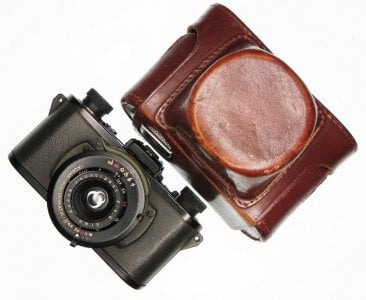
Military version of the Kodak 35 with original leather case. It's drop dead gorgeous and performs very well but it's a pricey primo collectible.
Best overall folding scale-focusing 35: Kodak Retina I (any model). They’re robust, beautifully made, and can take great pictures, but their primitive, manual release, uncoupled frame positioning and counter systems are annoying and can result in blank exposures. Shooters should opt for later postwar models (type 010 of 1945 to 1949 and type 013 of 1949 to 1951) which are chrome finished, have coated lenses, Compur-Rapid 1-1/500 sec plus B shutters with flash sync. and are widely available at $40.00 to $75.00. Early prewar models (type 117, 118 and 119) are beautiful in black and nickel finish, but they have uncoated lenses, are coveted collectibles, and can be quite pricey, especially the original type 117 of 1934, which can easily fetch $300 on up in pristine condition. Factoid for early-Retina I aficionados: Lenses marked Schneider Kreuznach Xenar are based on Schneider’s original optical formula, while those marked Schneider Kreuznach Retina Xenar employ Schneider’s newer tweaked formula, said to give better definition off axis and at the widest apertures.
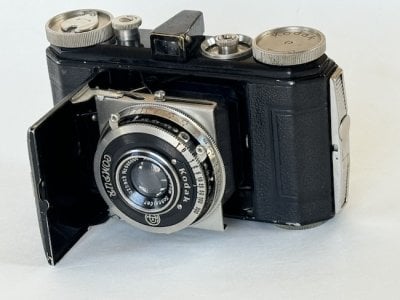
Kodak Retina I (Type 117) of 1934 was the first camera designed to take standard Kodak film cartridges. Sadly t's now a pricey collectible.
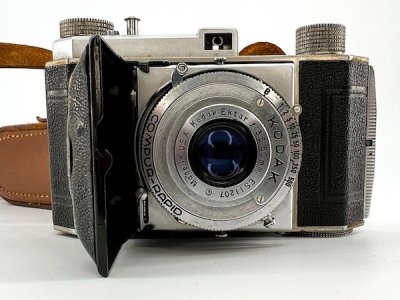
Kodak Retina I (Type 010) of the immediate postwar era is an affordable classic with a superb Made in U.S.A. coated 50mm f/3.5 Ektar lens.
The Welti, (by Welta) is a nice folding 35 and early postwar models fitted with a coated unit-focusing 50mm f/3.5 Zeiss Tessar in a Compur-Rapid 1-1/500 sec plus B shutter are very good shooters. Later models produced under the Pentacon banner sport a sharp 50mm f/2.8 Zeiss Jena Tessar T lens in an East German 1-1/200sec plus B Cludor shutter, which is OK, but harder to get repaired. Weltis from the ‘50s are well constructed and decently finished (but a cut below the Retina I in both respects), are afflicted with a similar uncoupled frame positioning and frame counting systems, and have a small, clear, tilting, top-mounted optical finder with parallax adjustments for infinity and N (near) positions. Having shot with many Weltis, I’d steer clear of prewar models fitted with the mediocre (and uncoated) 50mm f/2.9 Steinheil Cassar lens (prewar models with uncoated 50mmm f/3.5 Schneider Xenars are much better). Shooters should opt for the earliest postwar (1946-1951) model. which is remarkably well made for a camera produced in Dresden (a city that was levelled by the Allies) right after World War II. A Welti with a Tessar inn clean working condition will set you back $50 to $150 depending in condition so a late model Retina I is a better buy.
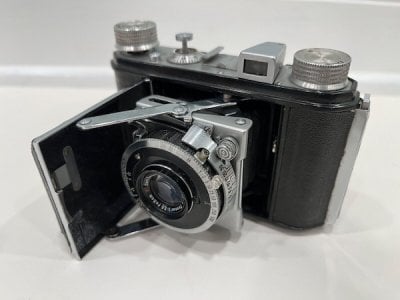
Early postwar Welti with coated 50mm f/3.5 Zeiss Jena Tessar in a Compeer-Rapid shutter. It's an engaging, competent, affordable folder.
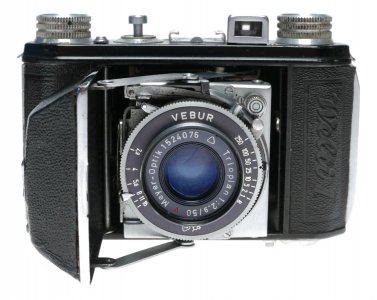
Late postwar Welti made by VEB Pentacon has a 50mm f/2.9 Meyer Trioplan lens in an East German Vebur shutter. It's a decent fun shooter.
A scale-focusing camera with a fast lens? Yes!
To the best if my knowledge, there was only one ultra-compact, noninterchangeable-lens, scale-focusing 35 that was available with an f/2 lens, the Edinex made by the Wirgin Brothers in Wiesbaden Germany starting around 1935. It had a collapsible lens that was pulled out to shooting position with a pair of finger grips, and its signature feature was an ultra slim body with a protruding, rounded “cylindrical” section on both ends. The Edinex was also marketed as the Midget Marvel and the Candid Midget in the U.S. and in Germany as the Adox Adrette after the Wirgin brothers (they were Jewish) departed Germany in the mid ‘30s. Less expensiive versions of the Edinex (and its branded variants) were fitted with front cell focusing lenses, but the expensive models if the early Edinex and Adrette sported fast unit-focusing lenses including a 4.5cm f/2 Schneider Xenon in a Compur-Rapid shutter. A cylindrical post on top of the camera was designed to accept an accessory (uncoupled) rangefinder, a good thing to have when focusing an f/2 lens at close distances! Regrettably, the Edinex with the f/2 Xenon lens is an exceedingly rare bird and likely to cost somewhere around of $400 to $600 (sorry, no photo). if you stumble across one. Models fitted with the Edinar lens, a 50mm f/2.8 Staeble Katoplast or a 50mm f/2.9 Meyer Trioplan (all 3-element triplets) are far more common, and affordable at around $35 to $75, but their coolness and collectability factors exceed their picture taking performance.
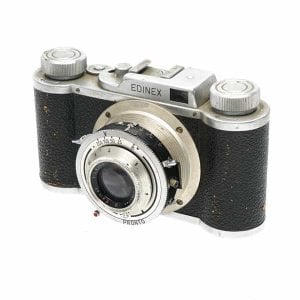
The uniquely contoured slimline Edinex. This is a low-end model with 3-element Edinar lens and Pronto shutter. The good news: it's cheap!
“Modern” scale-focusing 35s from the ‘60’s to the present.
The Rollei 35: The ultra-compact Rollei 35 was the smallest full-frame (24 x 36mm format) camera ever made when it was introduced at the Photokina exposition in 1966. It created a worldwide sensation, and about 2 million units in more than half a dozen different iterations, were manufactured over its impressive 30-year production run. The brainchild if Heinz Waaske, former chief designer of Wirgin (of Edixa fame), it employs a lens that retracts into the body, and an unconventional inter-lens leaf shutter (a ½-1/500 sec plus B “diaphragm shutter” by Compur). Waaske’s patented shutter design separated the mechanical “clockwork,” which was fixed within the camera body, from the shutter blades, which were mounted in the sliding lens tube. As a result, you had to cock the shutter before the lens (a sharp, front cell focusing 40mm f/3.5 Zeiss Tessar in the original model) could be retracted for storage. Other peculiar Rollei 35 features: a top-mounted lefthand wind lever, a bottom-mounted rewind crank and hot shoe, a slide-off back, and leftward film advance. The Rollei 35 has a built-in Gossen CdS cell match-needle meter coupled to the front-mounted aperture and shutter-speed dials, a small round meter port on the front, and an analog match-needle metering index on top.
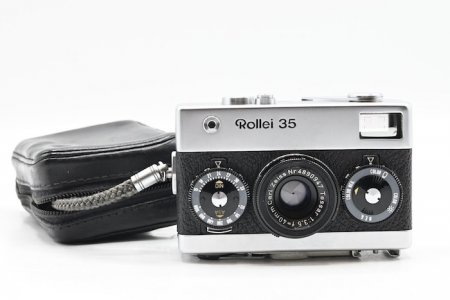
Original Rollei 35 with 40mm f/3.5 Zeiss Tessar lens. Note front mounted aperture (left) and shutter-speed dials, left-hand film wind lever.
While not the last word in convenience, the little Rollei 35 is a beautiful piece, pleasant to shoot with and capable of delivering excellent image quality—and it literally fits in your pocket, naked with a lens cap or in its cute fitted zippered pouch case. The camera measures 3-3/4 x 2-11/16, x 1-3/4 inches (W x H x D) and weighs in at 12-1/4 ounces. Like many cameras of its era, the Rollei 35’s meter was designed to take a discontinued Mallory PX 13 or equivalent 1.35v mercury cell and must be converted to work properly with a current 1.5v silver oxide cell. Pristine, fully functional Rollei 35 cameras in chrome with 40mm f/3.5 Tessar or S-Xenar lens are readily available on the major online action sites at prices in the $200.00 to $3$0.00 range. Models in black finish generally command higher prices as do models marked “Made in Germany” rather than “Made in Singapore” even though they’re virtually identical in terms of finish and performance.
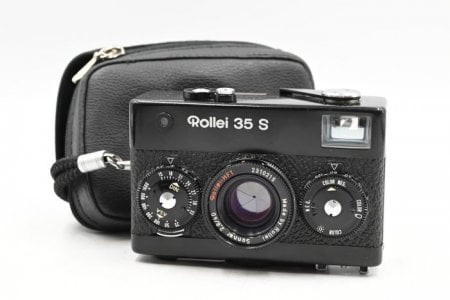
Rollei 35 S with Rollei-made unit-focusing 40mm f/2.8 Sonnar, the finest lens ever fitted to a Rollei 35. The 35S is pricey but worth it.
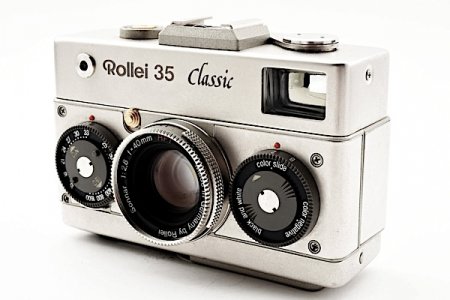
Limited Edition Rollei 35 Classic in platinum finish. Made in Germany, it's arguably the ultimate Rollei 35 but will set you back a grand!
We can’t possibly detail all the Rollei 35 variants here, which include models with LED readouts, economy models with 3-element Triotar lenses, and lenses with original Carl Zeiss or Made by Rollei markings, but here’s some general advice. Any Rollei 35 with a front-cell-focusing 40mm f/3.5 Tessar is capable of excellent performance, and the very best lens ever fitted to a Rollei 35 is the unit-focusing, 5-element, 4-group, 40mm f/2.8 Sonnar which is found on my favorite model, the Rollei 35 S, the Rollei 35 SE, which has LED meter readouts in the finder and takes a 6v PX 27 battery, and the posh limited edition Made in Germany Rollei 35 Classic in platinum finish. A pristine Rollei 35 S in black or chrome will set you back about $350.00 to $500.00; a Rollei 35 Classic fetches around $1K or a bit less, and a Made in Singapore Rollei 35 SE runs about $250.00 to $400.00.
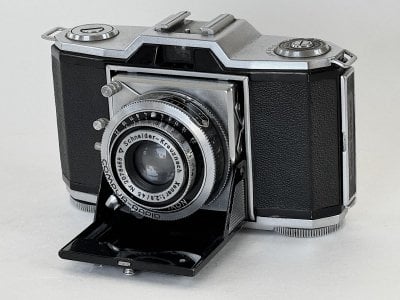
The Zeiss Contina of the early '50s. It's fitted with a 45mm f/2.8 Schneider Xenar because Zeiss lens production couldn't make enough Tessars!
The Zeiss Contina: These compact scale-focusing gems are divided into two body types, folding Continas (1948 to 1953) and rigid models (1953-1965). All are well made and durable and those with Tessar lenses are excellent picture takers, but the folding models designed by the great Hubert Nerwin are far more esthetic and pocketable. First released in 1938 as the Ikonta 35 522/24 the name was changed to Contina 522/24 in 1951.The Contina has a smooth top plate with controls around the front cell focusing, coated 4.5cm f/2.8 Schneider Xenar lens, which is mounted in a Compur-Rapid 1-1/500 sec plus B shutter with X sync only. The film wind and rewind knobs and frame counter are on the bottom. A small number of later models were fitted with the excellent 45mm f/2.8 Zeiss-Opton Tessar T lens and there were economy models with Novar and Novicar lenses in Pronto shutters. Unlike the Rollei 35 which has frame line and parallax compensation markings in the finder, folding Continas have small, clear optical finders devoid of frame lines. Folding Continas are elegant, beautifully finished, very well-made cameras capable of excellent imaging performance. They’re not as petite as a Rollei 35, but they will slide into a pocket or purse and are well protected when folded. Make sure yours has a Xenar or Tessar lens if you expect to take sharp pictures at wide apertures. Folding Continas with Xenar lenses are the most common but they’re not always easy to find in clean, fully working condition. However, when you do find one you can typically snag it for $75.00 to $150.00.
The Voigtlander Vito is a well-made, very competent folding, scale-focusing 35, the original Vito, made from 1939-1940 (identifiable by its hinged, built-in yellow filter and uncoated 50mm f/3.5 Skopar lens in Compur or Compur-Rapid shutter, and the Vito II made from 1947 to 1950, with a coated front cell focusing 50mm f/3.5 Color-Skopar lens (an excellent 4-element 3-group Tessar type) in a Compur Rapid 1-1/500 sec plus B or Prontor-S or SVS 1-1/300 sec plus B leaf shutter. The Vito II (with either shutter) is the one picture takers should opt for, but either one is an elegant and worthy machine. The good news: both are readily available on the used market at enticing prices ranging from $60.00 to $125.00.
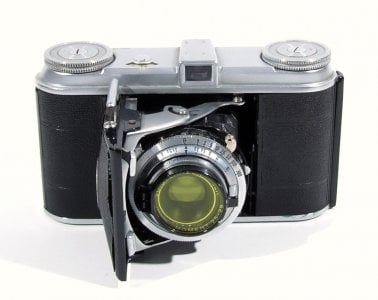
Prewar Voigtlander Vito 1 is identifiable by hinged yellow filter over the uncoated 50mm f/3.5 Skopar lens. It's pretty and a great shooter.
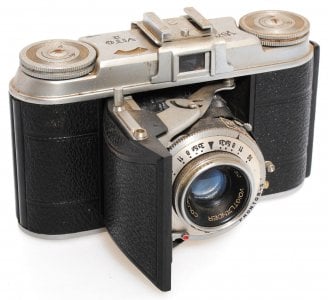
Postwar Voigtlander Vito II with coated 50mm f/3.5 Color-Skopar ens. This one has a Prontor-S shutter, OK but no Synchro-Compur!
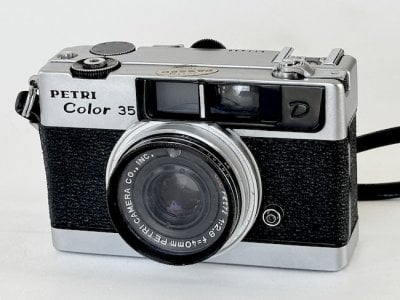
Petri Color 35: It's ingenious design lets you focus and meter with the camera held at eye level. It's also nicely made and performs very well.
The Petri Color 35: Many experts say a camera like this is what Rollei should have made instead of the Rollei 35, but that observation is a tad harsh because the Rollei was designed in 1962, debuted in 1966, and is smaller than the Petri. However, there’s no denying that the Petri Color 35, which debuted in 1968 is an audacious, ingenius, well executed design, and it may well be the best made camera Petri ever produced. It features a collapsible 40mm f/2.8 Perti lens (a 4-element, 3-group Tessar type) that moves out to shooting position by turning a small vertical wheel on the back of the camera clockwise until you reach a soft detent. The wheel is handily placed in between the viewfinder eyepiece and the smooth single stroke wind lever, and you set focusing distances ranging from infinity to 3 feet by turning the wheel further. Selected distances are read out in the finder via a clear horizontal scale and needle at the bottom of the viewfinder. The distance scale is conveniently located just below the projected yellow field frame line (which has one parallax correction line for composing at close distances). At the righthand edge of the frame line there’s a metering index and meter needle which you center over a red circle by turning the top-mounted shutter-speed wheel (1/15-1/250 sec plus B), which overhangs the front of the top plate, and/or the aperture (f/2.8 to f/22) dial, that overhangs the rear of the top plate. The little round port for the CdS meter cell is shoehorned into the top of the lens identification ring, and the meter was built to take a 1.35v PX 675 mercury battery and must be modified to give accurate readings with current 1.5v cells.
The Petri Color 35 is certainly a lot more convenient camera to shoot with than a Rollei 35 since all controls can be conveniently operated with the camera held at eye level. Foibles: It is possible to wind the film and fire the shutter even when the lens isn’t fully extended to the shooting range (which could result in out-of-focus images) and it’s easy to miss the “soft detent” when extending the lens. Some have complained that the metric and footage distances on the focusing scale are too sparse (there are near, far and middle-distance icons but no minimum distance number, only the “human head” close-up icon). Finally, many reviewers describe the little Petri’s lens as “good but not great” and claim isn’t t equal to the Tessar or Sonnar lenses on most Rollei 35s. Based on my experience, the 40mm f/3.5 Tessar on the Rollei may be a tad sharper at f/3.5 than the Petri lens at f/2.8, but otherwise they’re quite comparable. The 40mm f/2.8 Planar on the Rollei 35S is noticeably sharper than either, particularly at maximum aperture, and at f/4. Pristine, fully functional examples are excellent user-collector cameras, and you van generally snag one for $125.00 to $225.00, though mint ones can be higher. Avoid the Petri Color 35E, which looks almost identical to the Color 35, but is autoexposure only with no manual exposure settings.
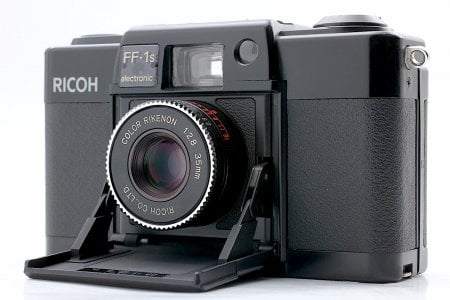
Ricoh FF-1s: A pocketable autoexposure folder with a fine lens and electronically controlled shutter, but no manual mode or exposure lock.
The Ricoh FF-1 of 1978 is an ultra-compact scale-focusing 35 with a 4-element, 3-group 35mm f/2.8 Rikenon lens that extends into shooting position when you swing down the hinged front door and retracts into the body to protect the lens when you swing the door upward to close it. Its electronically controlled leaf shutter provides shutter speeds of 2 to 1/500 sec, is powered by two currently available S76 or LR44 cells and won’t fire without battery power. The CdS metering system provides a choice of programmed or aperture priority autoexposure (no manual mode) and there’s an underexposure warning light but no exposure lock—pity! The aperture control on the lens works only with a flash in place, and (despite being a leaf shutter) only provides flash sync at 1/30 sec. The lens has a 3-bladed diaphragm (!) resulting in triangular specular highlights, and the ASA dial tops out at a blistering 400. The later Ricoh FF-1s is the same camera, but it locks the shutter if there’s no battery power, an improvement on the FF-1, which makes a clicking sound but doesn’t expose the film! The FF-1 and FF-1s are reasonably well made, fun to shoot with, have nicely contoured wind levers and clear frame line viewfinders. Despite their foibles they’re engagingly minuscule, attractive machines capable of excellent on-film performance. A clean fully functional Ricoh FF-1 or FF-1s generally runs about $90.00 to $120.00, but you can sometimes snag one for a lot less.
Want a scale-focusing 35 with a fast lens? Here are 2 half framers!
With the sole exception of one rare Edinex model we’ve covered earlier there are no full frame 35mm noninterchangeable lens cameras with lenses faster than f/2.8. But there are at least 4 half frame 35s that have noninterchangeable lenses faster than f/2. Here they are.
The Olympus Pen D-series: The original Olympus Pen of 1959 with the thumbwheel film advance was a minimalist half-frame masterpiece created by Yoshihisa Maitani, one if the great camera designers of the 20th century, who was also responsible for the landmark Olympus OM-1 that inspired the compact 35mm SLR Revolution of the ‘70s. The Olympus Pen was so successful that it spawned at least half a dozen half frame successors, all based on the same iconic form factor. These included the popular, more expensive Pen D series, launched in 1962 with the original Olympus Pen D, which sports a 32mm f/1.9 F. Zuiko lens, a 1/500 sec Copal shutter, and a built-in uncoupled selenium cell light meter. This was followed up in 1964 with the Olympus Pen D2, basically the same camera but with a CdS cell light meter, and the Olympus Pen D3 of 1965, basically the same as the D2, but with a slightly faster 32mm f/1.7 D. Zuiko lens. All Olympus Pen Ds have superb lenses, great ergonomics, and classic good looks, but the D2 and D3 CdS cell meters were designed to be powered by discontinued 1.35v PX 675 mercury cells and must be modified to give accurate readings with current 1.5v batteries, preferably the silver-oxide type. The Olympus Pen D, D2 and D3 are readily available in clean working condition at prices ranging from about $75.00 to $125.00, higher for models in mint condition with original box, pouch case, wrist strap, etc.
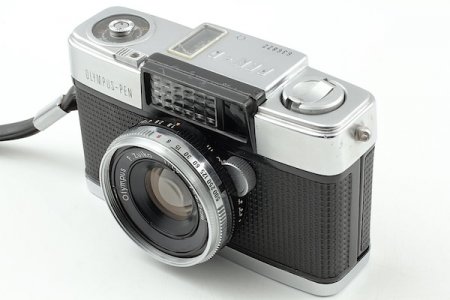
Original Olympus Pen D of 1962 has a superb 6-element 4-group 32mm f/1.9 F. Zuiko lens and a built-in uncoupled selenium cell meter.
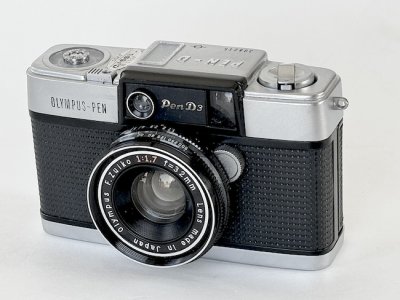
Olympus Pen D3, the last of the Pen D series, has a 32mm f/1.7 F. Zuiko lens and a built-in uncoupled CdS meter that took mercury cells.
The Canon Demi EE 1.7: With sharp Italianesque styling and a superb 6-element, 4-group Canon SH 30mm f/1.7 lens, this high-performance half framer provides a choice of shutter speed priority autoexposure using a CdS cell metering system, or full manual exposure settings—there’s no metered manual mode. The Seiko leaf shutter offers speeds of 1/8 to 1/500 sec plus B and aperture settings range from f/1.7 to f/16. Other key features: true projected finder frame line with parallax correction marking, in-finder distance settings using icons, complemented by metric and footage settings on the tab-controlled focusing ring, camera selected aperture readouts in AE mode, an ASA 25-400 film speed dial on the bottom, and a conventional wind lever and folding rewind crank on top. The Canon Demi EE 1.7 is fairly wide compared to other half frame 35s, but it’s slim, ergonomically contoured, comfortable to hold, and its controls “fall readily to hand.” It’s clearly a high-quality piece and capable of outstanding results, but you’ll have to convert its metering system, which was designed to take 1.35v mercury batteries, to give accurate exposures with current 1,5v silver oxide cells. A clean, fully functional Canon Demi EE 1.7 can be purchased for around $80.00 to $140.00; mint models with all the original packing, pouch case, wrist strap, etc. can run $200.00 and up.
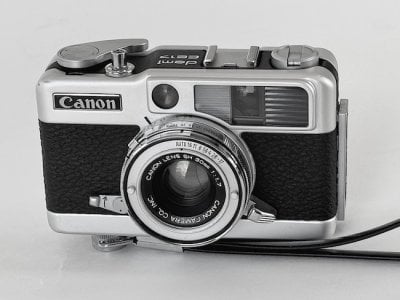
Canon Demi EE1.7 is a stylish half framer with a superlative Canon 30mm f/1.7 lens. The only thing it lacks is a metered manual mode.
Obviously, this does not pretend to be a complete list. Just looking over my own collection I found a Balda (a cute scale-focusing folder of the late ‘50s that resembles a cross between a Welti and a Kodak Retina I), and a compact but chunky solid bodied Olympus 35 of the early ‘50s with a semi-wide-angle 4cm f/3.5 F.C Zuiko lens. I’ve also deliberately excluded such fine autofocus compact 35s as the posh Minolta TC-1 and compact cult classic Yashica T4, and the beautiful Contax T folding rangefinder camera because I think they really belong in different categories. Finally, my apologies to Minox 35 fans for omitting the Minox 35 GT and its many versions even though it was the smallest 35mm camera in the world until 1995 when Minolta released the TC-1, which is a micro-tad smaller. Yes, Minox 35s have excellent four-element, 3-group Minotar/Minoxar lenses and they can take great pictures, but their bodies are made of (ugh!) fiberglass-reinforced Makrolon (plastic) and I would not personally buy one. I confess that I do love my Konica TC-X SLR which is all plastic except for the lens mount, so I guess you can mark me down as biased.
Pocket-sized scale-focusing 35s: Maxi performance in Mini packages!
By Jason Schneider
For some strange reason, sellers of vintage 35mm cameras often list scale-focusing models as “rangefinder cameras” which they assuredly are not. Although many would benefit by mounting a separate, uncoupled rangefinder in their accessory shoes (an inconvenient solution employed by many Leica I (Model A) shooters back in the day) scale focusing 35s are a separate species with a fascinating history of their own. Indeed, the best ones are superb, pocketable shooters even though few full-frame models are fitted with lenses faster than f/2.8.
In the beginning, all 35mm still picture cameras were scale focusing, and most of those made prior to the release of the Leica I (Model A) in 1925 were ponderous contraptions with large film capacities, many vertically configured like the cine cameras of the day, and all used the standard 18x24mm cine format. One early exception was the New York-made Simplex of 1914, a beautifully made but clunky machine with a horizontal form factor that gave a choice of 18x24mm and 24x36mm formats and sold for a then staggering price of $65. The genius of Oskar Barnack’s Leica was that it was an elegant, pocketable, “precision miniature” with a collapsible lens that automatically stopped at the next exposure, cocked the focal plane shutter, and advanced the film counter one notch as you turned the film-wind knob— pedestrian by today’s standards, but remarkably advanced a century ago. Even more important, the Leica I (Model A) established the basic form factor for practically every compact 35mm camera that succeeded it, up to and including all the compact scale-focusing 35s featured in Part 1 of this article. So, while the Leica was neither the first 35mm camera nor the first with the standard 24x36mm format it was the camera that put 35mm photography on the map.

Simplex camera of 1914 gave a choice of 18 x 24mm and 24 x 36mm formats. It was made in Long Island City, NY. Image courtesy Leica Shop.
From about 1925 to 1945, compact, scale-focusing 35mm cameras proliferated to meet the demands of photographers who wanted sophisticated compact cameras with full manual controls that were more affordable than a Leica or a Contax. Examples include the following folding 35s: the Kodak Retina I (produced in many versions by Kodak AG, Stuttgart, formerly Nagel Werk), the Welti, by Welta of Dresden (available in a variety of lens-shutter combos), the Voigtlander Vito (an elegant folder that debuted in 1936), the Beirette by Beier (1939) and the Certo Durata (rare scale focusing cousin of the better-known Certo Dollina rangefinder 35). Non-folding models include the Altix I (by EHOI-Altissa), the Photavit (aka Boltavit) by Bolta-Werk (1936), the collapsible-lens Edinex (later sold as the Adox Adrette) by Gebr. Wirgin of Wiesbaden, the rough and ready Reyna (first produced by Cornu of France in 1941 under German occupation!) and the lovably Spartan Kodak 35 of 1938, Kodak’s first U.S- made 35, produced in anticipation of the cessation of German imports during WWII.
Most of the above-mentioned cameras are fitted with 50mm f/3.5 Zeiss Tessar, Schneider Xenar, or Kodak Ektar lenses, all sharp, high quality 4-element, 3-group designs. If you want something a bit faster you must settle for a triplet lens such as a 50mm f/2.9 Meyer Trioplan (pretty good), or a 50mm f/2.9 Schneder Radionar (OK, but not as good as the Trioplan). There was one glorious exception we’ll get to shortly.
My favorite scale focusing compact 35s.
The Kodak 35: Bearing a slight resemblance to the German Wirgin Edinex, this minimalist charmer features a precision molded black Bakelite body with satin-chromed top and base plates, and a collapsible frame viewfinder centrally mounted on top. The back/baseplate unit slides easily off for easy film loading and is secured by a centrally located wing key. Turning the key also slackens the spring tension of the chromed steel film pressure plate, an unusual feature probably intended to facilitate reassembling the camera rather than to preventing film scratching, which would have been a novel feature. The Kodak 35 has a manually reset automatic frame counter, a chromed wind-on release button, and a rigidly mounted front-cell-focusing Kodak lens set in a Kodak inter-lens leaf shutter. The shutter is cocked by a gear coupled to the sprocket shaft that turns as the film is advanced, so the shutter can’t normally be cocked unless there’s film in the camera. An automatic mechanism locks the film wind knob when the next frame is in shooting position and it’s released by depressing the wind-on release button before you advance to the next exposure This simple system prevents double exposures, but not blank frames since nothing prevents you from pressing the button again and advancing the film. However, a red indicator in a slot atop the shutter housing indicates the camera has been wound. The shutter release itself, a rearward-pointing pin attached to the shutter release lever, is located at about 10 o'clock on the shutter housing, and it’s protected from accidental release by a small cover extending over it.

Kodak 35 with 50mm f/3.5 Kodak Anastigmat Special lens (a front-cell-focusing Tessar type). It's a fun camera that performs remarkably well.
The Kodak 35 is a fun camera to shoot with, and a surprisingly adept picture taker, especially if you opt for one with the excellent 4-element Kodak Anastigmat Special or Kodak Anastar lens: Recommended models: Kodak 35 of 1938–1949 with 50mm f/3.5 Kodak Anastigmat Special lens in Kodamatic shutter and Kodak 35 of 1947–1948 with 51mm f/3.5 Kodak Anastigmat Special lens in Flash Kodamatic shutter. Bad news/good news: they’re not easy to find with these lenses but typically sell in the $25 to $75 range when you do. Collector’s heartthrob: the gorgeous, limited edition Military Green and black Kodak 35 PH324 made for the U.S. Armed Forces. It’s fitted with a 51mm f/4.5 Kodak Anastigmat lens (a fine-performing triplet) and currently fetches prices in the $500 to $800 range!

Military version of the Kodak 35 with original leather case. It's drop dead gorgeous and performs very well but it's a pricey primo collectible.
Best overall folding scale-focusing 35: Kodak Retina I (any model). They’re robust, beautifully made, and can take great pictures, but their primitive, manual release, uncoupled frame positioning and counter systems are annoying and can result in blank exposures. Shooters should opt for later postwar models (type 010 of 1945 to 1949 and type 013 of 1949 to 1951) which are chrome finished, have coated lenses, Compur-Rapid 1-1/500 sec plus B shutters with flash sync. and are widely available at $40.00 to $75.00. Early prewar models (type 117, 118 and 119) are beautiful in black and nickel finish, but they have uncoated lenses, are coveted collectibles, and can be quite pricey, especially the original type 117 of 1934, which can easily fetch $300 on up in pristine condition. Factoid for early-Retina I aficionados: Lenses marked Schneider Kreuznach Xenar are based on Schneider’s original optical formula, while those marked Schneider Kreuznach Retina Xenar employ Schneider’s newer tweaked formula, said to give better definition off axis and at the widest apertures.

Kodak Retina I (Type 117) of 1934 was the first camera designed to take standard Kodak film cartridges. Sadly t's now a pricey collectible.

Kodak Retina I (Type 010) of the immediate postwar era is an affordable classic with a superb Made in U.S.A. coated 50mm f/3.5 Ektar lens.
The Welti, (by Welta) is a nice folding 35 and early postwar models fitted with a coated unit-focusing 50mm f/3.5 Zeiss Tessar in a Compur-Rapid 1-1/500 sec plus B shutter are very good shooters. Later models produced under the Pentacon banner sport a sharp 50mm f/2.8 Zeiss Jena Tessar T lens in an East German 1-1/200sec plus B Cludor shutter, which is OK, but harder to get repaired. Weltis from the ‘50s are well constructed and decently finished (but a cut below the Retina I in both respects), are afflicted with a similar uncoupled frame positioning and frame counting systems, and have a small, clear, tilting, top-mounted optical finder with parallax adjustments for infinity and N (near) positions. Having shot with many Weltis, I’d steer clear of prewar models fitted with the mediocre (and uncoated) 50mm f/2.9 Steinheil Cassar lens (prewar models with uncoated 50mmm f/3.5 Schneider Xenars are much better). Shooters should opt for the earliest postwar (1946-1951) model. which is remarkably well made for a camera produced in Dresden (a city that was levelled by the Allies) right after World War II. A Welti with a Tessar inn clean working condition will set you back $50 to $150 depending in condition so a late model Retina I is a better buy.

Early postwar Welti with coated 50mm f/3.5 Zeiss Jena Tessar in a Compeer-Rapid shutter. It's an engaging, competent, affordable folder.

Late postwar Welti made by VEB Pentacon has a 50mm f/2.9 Meyer Trioplan lens in an East German Vebur shutter. It's a decent fun shooter.
A scale-focusing camera with a fast lens? Yes!
To the best if my knowledge, there was only one ultra-compact, noninterchangeable-lens, scale-focusing 35 that was available with an f/2 lens, the Edinex made by the Wirgin Brothers in Wiesbaden Germany starting around 1935. It had a collapsible lens that was pulled out to shooting position with a pair of finger grips, and its signature feature was an ultra slim body with a protruding, rounded “cylindrical” section on both ends. The Edinex was also marketed as the Midget Marvel and the Candid Midget in the U.S. and in Germany as the Adox Adrette after the Wirgin brothers (they were Jewish) departed Germany in the mid ‘30s. Less expensiive versions of the Edinex (and its branded variants) were fitted with front cell focusing lenses, but the expensive models if the early Edinex and Adrette sported fast unit-focusing lenses including a 4.5cm f/2 Schneider Xenon in a Compur-Rapid shutter. A cylindrical post on top of the camera was designed to accept an accessory (uncoupled) rangefinder, a good thing to have when focusing an f/2 lens at close distances! Regrettably, the Edinex with the f/2 Xenon lens is an exceedingly rare bird and likely to cost somewhere around of $400 to $600 (sorry, no photo). if you stumble across one. Models fitted with the Edinar lens, a 50mm f/2.8 Staeble Katoplast or a 50mm f/2.9 Meyer Trioplan (all 3-element triplets) are far more common, and affordable at around $35 to $75, but their coolness and collectability factors exceed their picture taking performance.

The uniquely contoured slimline Edinex. This is a low-end model with 3-element Edinar lens and Pronto shutter. The good news: it's cheap!
“Modern” scale-focusing 35s from the ‘60’s to the present.
The Rollei 35: The ultra-compact Rollei 35 was the smallest full-frame (24 x 36mm format) camera ever made when it was introduced at the Photokina exposition in 1966. It created a worldwide sensation, and about 2 million units in more than half a dozen different iterations, were manufactured over its impressive 30-year production run. The brainchild if Heinz Waaske, former chief designer of Wirgin (of Edixa fame), it employs a lens that retracts into the body, and an unconventional inter-lens leaf shutter (a ½-1/500 sec plus B “diaphragm shutter” by Compur). Waaske’s patented shutter design separated the mechanical “clockwork,” which was fixed within the camera body, from the shutter blades, which were mounted in the sliding lens tube. As a result, you had to cock the shutter before the lens (a sharp, front cell focusing 40mm f/3.5 Zeiss Tessar in the original model) could be retracted for storage. Other peculiar Rollei 35 features: a top-mounted lefthand wind lever, a bottom-mounted rewind crank and hot shoe, a slide-off back, and leftward film advance. The Rollei 35 has a built-in Gossen CdS cell match-needle meter coupled to the front-mounted aperture and shutter-speed dials, a small round meter port on the front, and an analog match-needle metering index on top.

Original Rollei 35 with 40mm f/3.5 Zeiss Tessar lens. Note front mounted aperture (left) and shutter-speed dials, left-hand film wind lever.
While not the last word in convenience, the little Rollei 35 is a beautiful piece, pleasant to shoot with and capable of delivering excellent image quality—and it literally fits in your pocket, naked with a lens cap or in its cute fitted zippered pouch case. The camera measures 3-3/4 x 2-11/16, x 1-3/4 inches (W x H x D) and weighs in at 12-1/4 ounces. Like many cameras of its era, the Rollei 35’s meter was designed to take a discontinued Mallory PX 13 or equivalent 1.35v mercury cell and must be converted to work properly with a current 1.5v silver oxide cell. Pristine, fully functional Rollei 35 cameras in chrome with 40mm f/3.5 Tessar or S-Xenar lens are readily available on the major online action sites at prices in the $200.00 to $3$0.00 range. Models in black finish generally command higher prices as do models marked “Made in Germany” rather than “Made in Singapore” even though they’re virtually identical in terms of finish and performance.

Rollei 35 S with Rollei-made unit-focusing 40mm f/2.8 Sonnar, the finest lens ever fitted to a Rollei 35. The 35S is pricey but worth it.

Limited Edition Rollei 35 Classic in platinum finish. Made in Germany, it's arguably the ultimate Rollei 35 but will set you back a grand!
We can’t possibly detail all the Rollei 35 variants here, which include models with LED readouts, economy models with 3-element Triotar lenses, and lenses with original Carl Zeiss or Made by Rollei markings, but here’s some general advice. Any Rollei 35 with a front-cell-focusing 40mm f/3.5 Tessar is capable of excellent performance, and the very best lens ever fitted to a Rollei 35 is the unit-focusing, 5-element, 4-group, 40mm f/2.8 Sonnar which is found on my favorite model, the Rollei 35 S, the Rollei 35 SE, which has LED meter readouts in the finder and takes a 6v PX 27 battery, and the posh limited edition Made in Germany Rollei 35 Classic in platinum finish. A pristine Rollei 35 S in black or chrome will set you back about $350.00 to $500.00; a Rollei 35 Classic fetches around $1K or a bit less, and a Made in Singapore Rollei 35 SE runs about $250.00 to $400.00.

The Zeiss Contina of the early '50s. It's fitted with a 45mm f/2.8 Schneider Xenar because Zeiss lens production couldn't make enough Tessars!
The Zeiss Contina: These compact scale-focusing gems are divided into two body types, folding Continas (1948 to 1953) and rigid models (1953-1965). All are well made and durable and those with Tessar lenses are excellent picture takers, but the folding models designed by the great Hubert Nerwin are far more esthetic and pocketable. First released in 1938 as the Ikonta 35 522/24 the name was changed to Contina 522/24 in 1951.The Contina has a smooth top plate with controls around the front cell focusing, coated 4.5cm f/2.8 Schneider Xenar lens, which is mounted in a Compur-Rapid 1-1/500 sec plus B shutter with X sync only. The film wind and rewind knobs and frame counter are on the bottom. A small number of later models were fitted with the excellent 45mm f/2.8 Zeiss-Opton Tessar T lens and there were economy models with Novar and Novicar lenses in Pronto shutters. Unlike the Rollei 35 which has frame line and parallax compensation markings in the finder, folding Continas have small, clear optical finders devoid of frame lines. Folding Continas are elegant, beautifully finished, very well-made cameras capable of excellent imaging performance. They’re not as petite as a Rollei 35, but they will slide into a pocket or purse and are well protected when folded. Make sure yours has a Xenar or Tessar lens if you expect to take sharp pictures at wide apertures. Folding Continas with Xenar lenses are the most common but they’re not always easy to find in clean, fully working condition. However, when you do find one you can typically snag it for $75.00 to $150.00.
The Voigtlander Vito is a well-made, very competent folding, scale-focusing 35, the original Vito, made from 1939-1940 (identifiable by its hinged, built-in yellow filter and uncoated 50mm f/3.5 Skopar lens in Compur or Compur-Rapid shutter, and the Vito II made from 1947 to 1950, with a coated front cell focusing 50mm f/3.5 Color-Skopar lens (an excellent 4-element 3-group Tessar type) in a Compur Rapid 1-1/500 sec plus B or Prontor-S or SVS 1-1/300 sec plus B leaf shutter. The Vito II (with either shutter) is the one picture takers should opt for, but either one is an elegant and worthy machine. The good news: both are readily available on the used market at enticing prices ranging from $60.00 to $125.00.

Prewar Voigtlander Vito 1 is identifiable by hinged yellow filter over the uncoated 50mm f/3.5 Skopar lens. It's pretty and a great shooter.

Postwar Voigtlander Vito II with coated 50mm f/3.5 Color-Skopar ens. This one has a Prontor-S shutter, OK but no Synchro-Compur!

Petri Color 35: It's ingenious design lets you focus and meter with the camera held at eye level. It's also nicely made and performs very well.
The Petri Color 35: Many experts say a camera like this is what Rollei should have made instead of the Rollei 35, but that observation is a tad harsh because the Rollei was designed in 1962, debuted in 1966, and is smaller than the Petri. However, there’s no denying that the Petri Color 35, which debuted in 1968 is an audacious, ingenius, well executed design, and it may well be the best made camera Petri ever produced. It features a collapsible 40mm f/2.8 Perti lens (a 4-element, 3-group Tessar type) that moves out to shooting position by turning a small vertical wheel on the back of the camera clockwise until you reach a soft detent. The wheel is handily placed in between the viewfinder eyepiece and the smooth single stroke wind lever, and you set focusing distances ranging from infinity to 3 feet by turning the wheel further. Selected distances are read out in the finder via a clear horizontal scale and needle at the bottom of the viewfinder. The distance scale is conveniently located just below the projected yellow field frame line (which has one parallax correction line for composing at close distances). At the righthand edge of the frame line there’s a metering index and meter needle which you center over a red circle by turning the top-mounted shutter-speed wheel (1/15-1/250 sec plus B), which overhangs the front of the top plate, and/or the aperture (f/2.8 to f/22) dial, that overhangs the rear of the top plate. The little round port for the CdS meter cell is shoehorned into the top of the lens identification ring, and the meter was built to take a 1.35v PX 675 mercury battery and must be modified to give accurate readings with current 1.5v cells.
The Petri Color 35 is certainly a lot more convenient camera to shoot with than a Rollei 35 since all controls can be conveniently operated with the camera held at eye level. Foibles: It is possible to wind the film and fire the shutter even when the lens isn’t fully extended to the shooting range (which could result in out-of-focus images) and it’s easy to miss the “soft detent” when extending the lens. Some have complained that the metric and footage distances on the focusing scale are too sparse (there are near, far and middle-distance icons but no minimum distance number, only the “human head” close-up icon). Finally, many reviewers describe the little Petri’s lens as “good but not great” and claim isn’t t equal to the Tessar or Sonnar lenses on most Rollei 35s. Based on my experience, the 40mm f/3.5 Tessar on the Rollei may be a tad sharper at f/3.5 than the Petri lens at f/2.8, but otherwise they’re quite comparable. The 40mm f/2.8 Planar on the Rollei 35S is noticeably sharper than either, particularly at maximum aperture, and at f/4. Pristine, fully functional examples are excellent user-collector cameras, and you van generally snag one for $125.00 to $225.00, though mint ones can be higher. Avoid the Petri Color 35E, which looks almost identical to the Color 35, but is autoexposure only with no manual exposure settings.

Ricoh FF-1s: A pocketable autoexposure folder with a fine lens and electronically controlled shutter, but no manual mode or exposure lock.
The Ricoh FF-1 of 1978 is an ultra-compact scale-focusing 35 with a 4-element, 3-group 35mm f/2.8 Rikenon lens that extends into shooting position when you swing down the hinged front door and retracts into the body to protect the lens when you swing the door upward to close it. Its electronically controlled leaf shutter provides shutter speeds of 2 to 1/500 sec, is powered by two currently available S76 or LR44 cells and won’t fire without battery power. The CdS metering system provides a choice of programmed or aperture priority autoexposure (no manual mode) and there’s an underexposure warning light but no exposure lock—pity! The aperture control on the lens works only with a flash in place, and (despite being a leaf shutter) only provides flash sync at 1/30 sec. The lens has a 3-bladed diaphragm (!) resulting in triangular specular highlights, and the ASA dial tops out at a blistering 400. The later Ricoh FF-1s is the same camera, but it locks the shutter if there’s no battery power, an improvement on the FF-1, which makes a clicking sound but doesn’t expose the film! The FF-1 and FF-1s are reasonably well made, fun to shoot with, have nicely contoured wind levers and clear frame line viewfinders. Despite their foibles they’re engagingly minuscule, attractive machines capable of excellent on-film performance. A clean fully functional Ricoh FF-1 or FF-1s generally runs about $90.00 to $120.00, but you can sometimes snag one for a lot less.
Want a scale-focusing 35 with a fast lens? Here are 2 half framers!
With the sole exception of one rare Edinex model we’ve covered earlier there are no full frame 35mm noninterchangeable lens cameras with lenses faster than f/2.8. But there are at least 4 half frame 35s that have noninterchangeable lenses faster than f/2. Here they are.
The Olympus Pen D-series: The original Olympus Pen of 1959 with the thumbwheel film advance was a minimalist half-frame masterpiece created by Yoshihisa Maitani, one if the great camera designers of the 20th century, who was also responsible for the landmark Olympus OM-1 that inspired the compact 35mm SLR Revolution of the ‘70s. The Olympus Pen was so successful that it spawned at least half a dozen half frame successors, all based on the same iconic form factor. These included the popular, more expensive Pen D series, launched in 1962 with the original Olympus Pen D, which sports a 32mm f/1.9 F. Zuiko lens, a 1/500 sec Copal shutter, and a built-in uncoupled selenium cell light meter. This was followed up in 1964 with the Olympus Pen D2, basically the same camera but with a CdS cell light meter, and the Olympus Pen D3 of 1965, basically the same as the D2, but with a slightly faster 32mm f/1.7 D. Zuiko lens. All Olympus Pen Ds have superb lenses, great ergonomics, and classic good looks, but the D2 and D3 CdS cell meters were designed to be powered by discontinued 1.35v PX 675 mercury cells and must be modified to give accurate readings with current 1.5v batteries, preferably the silver-oxide type. The Olympus Pen D, D2 and D3 are readily available in clean working condition at prices ranging from about $75.00 to $125.00, higher for models in mint condition with original box, pouch case, wrist strap, etc.

Original Olympus Pen D of 1962 has a superb 6-element 4-group 32mm f/1.9 F. Zuiko lens and a built-in uncoupled selenium cell meter.

Olympus Pen D3, the last of the Pen D series, has a 32mm f/1.7 F. Zuiko lens and a built-in uncoupled CdS meter that took mercury cells.
The Canon Demi EE 1.7: With sharp Italianesque styling and a superb 6-element, 4-group Canon SH 30mm f/1.7 lens, this high-performance half framer provides a choice of shutter speed priority autoexposure using a CdS cell metering system, or full manual exposure settings—there’s no metered manual mode. The Seiko leaf shutter offers speeds of 1/8 to 1/500 sec plus B and aperture settings range from f/1.7 to f/16. Other key features: true projected finder frame line with parallax correction marking, in-finder distance settings using icons, complemented by metric and footage settings on the tab-controlled focusing ring, camera selected aperture readouts in AE mode, an ASA 25-400 film speed dial on the bottom, and a conventional wind lever and folding rewind crank on top. The Canon Demi EE 1.7 is fairly wide compared to other half frame 35s, but it’s slim, ergonomically contoured, comfortable to hold, and its controls “fall readily to hand.” It’s clearly a high-quality piece and capable of outstanding results, but you’ll have to convert its metering system, which was designed to take 1.35v mercury batteries, to give accurate exposures with current 1,5v silver oxide cells. A clean, fully functional Canon Demi EE 1.7 can be purchased for around $80.00 to $140.00; mint models with all the original packing, pouch case, wrist strap, etc. can run $200.00 and up.

Canon Demi EE1.7 is a stylish half framer with a superlative Canon 30mm f/1.7 lens. The only thing it lacks is a metered manual mode.
Obviously, this does not pretend to be a complete list. Just looking over my own collection I found a Balda (a cute scale-focusing folder of the late ‘50s that resembles a cross between a Welti and a Kodak Retina I), and a compact but chunky solid bodied Olympus 35 of the early ‘50s with a semi-wide-angle 4cm f/3.5 F.C Zuiko lens. I’ve also deliberately excluded such fine autofocus compact 35s as the posh Minolta TC-1 and compact cult classic Yashica T4, and the beautiful Contax T folding rangefinder camera because I think they really belong in different categories. Finally, my apologies to Minox 35 fans for omitting the Minox 35 GT and its many versions even though it was the smallest 35mm camera in the world until 1995 when Minolta released the TC-1, which is a micro-tad smaller. Yes, Minox 35s have excellent four-element, 3-group Minotar/Minoxar lenses and they can take great pictures, but their bodies are made of (ugh!) fiberglass-reinforced Makrolon (plastic) and I would not personally buy one. I confess that I do love my Konica TC-X SLR which is all plastic except for the lens mount, so I guess you can mark me down as biased.
Last edited:
largedrink
Down Under
Nice article Jason, thank you. I own a few of these cameras including a nice Retina 118. Ed Hillary used a Retina 118 to take the famous photo of Sherpa Tenzing at the top of Everest. His had the Carl Zeiss Jena Tessar lens.
wlewisiii
Just another hotel clerk
Kai-san
Filmwaster
My Edinex has got the Schneider-Kreuznach Xenar 2.8/5cm and helicoid focussing, here with a Leitz rangefinder. The Xenar lens has excellent sharpness, don't think I'll gain much with a Xenon. Extremely fun camera to shoot, I carry it on a hand strap. This must be one if the best examples of form follows function.
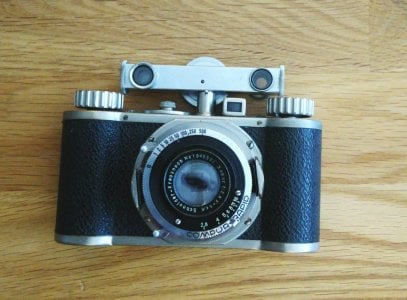

"Factoid for early-Retina I aficionados: Lenses marked Schneider Kreuznach Xenar are based on Schneider’s original optical formula, while those marked Schneider Kreuznach Retina Xenar employ Schneider’s newer tweaked formula, said to give better definition off axis and at the widest apertures."
@Jason Schneider - Does this mean it uses the 5-element version of the Schneider Xenar 5cm F2.8?I picked up a coated Xenar at a camera show, loose- was hazy. Took it apart to discover it was a 5-element lens, the front element of a typical Xenar/Tessar had been split into two thinner elements. It is a very good performer. I used a Canon 50/2.8 LTM mount to "hack" it for Leica.
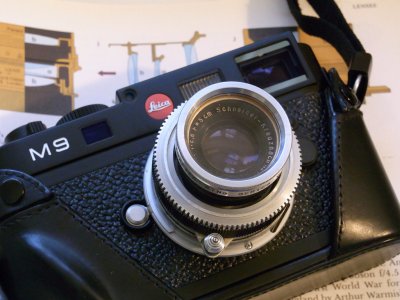
The SN on this one puts it as a wartime lens, it is fully coated.
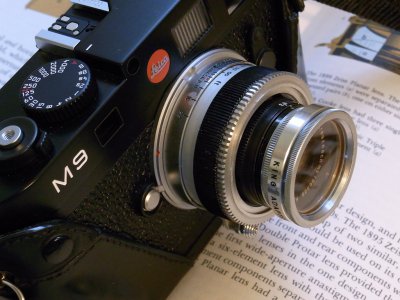
@Jason Schneider - Does this mean it uses the 5-element version of the Schneider Xenar 5cm F2.8?I picked up a coated Xenar at a camera show, loose- was hazy. Took it apart to discover it was a 5-element lens, the front element of a typical Xenar/Tessar had been split into two thinner elements. It is a very good performer. I used a Canon 50/2.8 LTM mount to "hack" it for Leica.

The SN on this one puts it as a wartime lens, it is fully coated.

Jason Schneider
the Camera Collector
Congratulations! That's a very nice Edinex indeed--I'm guessing early postwar based on the lens serial number and Compur-Rapid shutter. The Xenar is certainly a fine lens. Use iit well!My Edinex has got the Schneider-Kreuznach Xenar 2.8/5cm and helicoid focussing, here with a Leitz rangefinder. The Xenar lens has excellent sharpness, don't think I'll gain much with a Xenon. Extremely fun camera to shoot, I carry it on a hand strap. This must be one if the best examples of form follows function.
View attachment 4835128
The T is actually a true rangefinder. T4 is now $400-$600!I’ve also deliberately excluded such fine autofocus compact 35s as the posh Minolta TC-1 and Contax T and the affordable cult classic Yashica T4 because I think they really belong in a different category.
Jason Schneider
the Camera Collector
Fascinating! To the best of my knowledge the Schneider-Retina-Xenar on early Retina I cameras is a slightly improved version of the classic 4-element, 3-group Schneider-Kreuznach-Xenar and not a 5-element lens. At any rate it's a 50mm f/3.5, not an f/2.8. But I've never taken one apart so perhaps an experienced camera repair person who has can tell us for sure,"Factoid for early-Retina I aficionados: Lenses marked Schneider Kreuznach Xenar are based on Schneider’s original optical formula, while those marked Schneider Kreuznach Retina Xenar employ Schneider’s newer tweaked formula, said to give better definition off axis and at the widest apertures."
@Jason Schneider - Does this mean it uses the 5-element version of the Schneider Xenar 5cm F2.8?I picked up a coated Xenar at a camera show, loose- was hazy. Took it apart to discover it was a 5-element lens, the front element of a typical Xenar/Tessar had been split into two thinner elements. It is a very good performer. I used a Canon 50/2.8 LTM mount to "hack" it for Leica.
View attachment 4835139
The SN on this one puts it as a wartime lens, it is fully coated.
View attachment 4835140
Last edited:
Dralowid
Michael
Ah, Weltini could be had with an f2 Schneider Xenon or a Leitz Elmar?
However the Weltini is somewhat ergonomically challenged.
The Elmar was also offered as an option on another folding camera but can't remember which.
However the Weltini is somewhat ergonomically challenged.
The Elmar was also offered as an option on another folding camera but can't remember which.
retinax
Well-known
You write about the Rollei 35S having a planar - I've read that if it's a true sonnar is debated, but is it really a planar or is that an error?
Jason Schneider
the Camera Collector
Not guilty! I've just gone over the section on the Rollei 35 in this article and I consistently referred to it as a 40mm f/2.8 Sonnar.You write about the Rollei 35S having a planar - I've read that if it's a true sonnar is debated, but is it really a planar or is that an error?
Jason Schneider
the Camera Collector
Thanks for your correction. You're right--the Contax T is a classic rangefinder camera not an AF, so I shouldn't have lumped it in with the Minolta TC-1 and Yashica T4, which are both AF cameras. I will revise the text.The T is actually a true rangefinder. T4 is now $400-$600!
ChrisPlatt
Thread Killer
Jason Schneider
the Camera Collector
The Welta-made camera I covered in this piece is the Welti, a scale-focusing folder, not the Weltini, which has a built-in coupled rangefinder and was available with a 50mm f/2 Schneider Xenon or a Leitz Elmar. My personal Weltini has a 5cm f/2.8 Schneider Xenar, which performs very well. I wouldn't go so far as calling it "ergonomically challenged," because it's OK once you get used to its unconventional control placement. However when I want to shoot with a rangefinder camera of this vintage I usually reach for my Retina II with 50mm f/2 Rodenstock Heligon.Ah, Weltini could be had with an f2 Schneider Xenon or a Leitz Elmar?
However the Weltini is somewhat ergonomically challenged.
The Elmar was also offered as an option on another folding camera but can't remember which.
BernardL
Well-known
@Jason Schneider. Thank you for this (and other similar) informative articles. I'm pleased to see that I own several of the cameras you mention here, mostly acquired "in the wild" at rummage sales or from the 5-€ bin. Below two of my Retinas. Left Retina I type 010, right Retina type 117, for which I had to fabricate the missing spade(?) shaped part to switch shoot/rewind, plus re-painting the top.
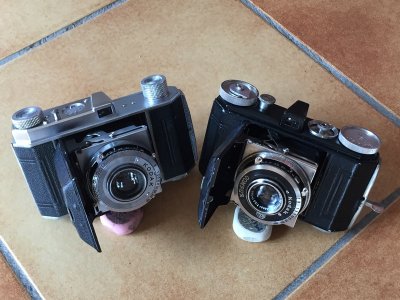

wlewisiii
Just another hotel clerk
Oh that is such a gorgeous bit of work Brian. Thank you for sharing it with us!"Factoid for early-Retina I aficionados: Lenses marked Schneider Kreuznach Xenar are based on Schneider’s original optical formula, while those marked Schneider Kreuznach Retina Xenar employ Schneider’s newer tweaked formula, said to give better definition off axis and at the widest apertures."
@Jason Schneider - Does this mean it uses the 5-element version of the Schneider Xenar 5cm F2.8?I picked up a coated Xenar at a camera show, loose- was hazy. Took it apart to discover it was a 5-element lens, the front element of a typical Xenar/Tessar had been split into two thinner elements. It is a very good performer. I used a Canon 50/2.8 LTM mount to "hack" it for Leica.
View attachment 4835139
The SN on this one puts it as a wartime lens, it is fully coated.
View attachment 4835140
css9450
Mentor
Nice to see the Vito series getting some attention! I have an original pre-war Vito and also a Vito B which probably dates from the late 50s. Both are excellent picture takers. The way the lens, shutter and bellows kind of rolls out of the older Vito's body never fails to amuse me! Its film winding and shutter-advancing mechanism is quite interesting.... "Supposedly" when the camera was originally designed, it was intended to use 828 film, or perhaps some other type of non-perforated 35mm film, so instead of utilizing the sprocket holes it "drags" the film across a toothed roller which a) primes the shutter and b) advances the frame counter. Sounds crazy but it works just fine. It's also unusual because I have to trim the film leader to fit into the takeup spool, which apparently was designed for a different style of leader.
ranger9
Well-known
Topic-adjacent at best, but since it was mentioned a few times in Jason's fabulous post, can anyone suggest a good pointer to an exact, accurate description of the process of converting 1.35v mercury-cell cameras to work accurately with a 1.5v silver-oxide cell? I've read several casual descriptions that don't make sense electrically, and simply re-zeroing the meter via its mechanical adjustment definitely is NOT going to work because the circuitry is non-linear. The most reliable-sounding description I've seen involves running the battery output through two zener [update: Schottky] diodes in series (a part number would be helpful!); supposedly these have just enough voltage drop to knock the final output down to 1.35-ish v, although I believe this setup does NOT take advantage of the "zener effect" and consequently doesn't provide any regulation as the silver-oxide cell's voltage gradually declines (one thing that made mercury cells hard to replace is that their voltage output remained almost perfectly flat throughout most of their life, and once they gave up the ghost they went to 0v almost immediately, eliminating any ambiguity!)
Meanwhile, I remember seeing a data sheet indicating that Toshiba made a voltage-converter IC that shifted 1.5v to a regulated 1.35v and that this was what the original MR-9 adapter used (vs. all the numerous fakes that have no circuitry at all except a dropping resistor.) This sounds like the ideal conversion option, but I haven't been able to find out any specifics on how it could be done.
Meanwhile, I remember seeing a data sheet indicating that Toshiba made a voltage-converter IC that shifted 1.5v to a regulated 1.35v and that this was what the original MR-9 adapter used (vs. all the numerous fakes that have no circuitry at all except a dropping resistor.) This sounds like the ideal conversion option, but I haven't been able to find out any specifics on how it could be done.
Last edited:
BernardL
Well-known
Definitely not Zener diodes, which typically have a voltage drop of several volts, even less two in seriesTopic-adjacent at best, but since it was mentioned a few times in Jason's fabulous post, can anyone suggest a good pointer to an exact, accurate description of the process of converting 1.35v mercury-cell cameras to work accurately with a 1.5v silver-oxide cell? I've read several casual descriptions that don't make sense electrically, and simply re-zeroing the meter via its mechanical adjustment definitely is NOT going to work because the circuitry is non-linear. The most reliable-sounding description I've seen involves running the battery output through two zener diodes in series (a part number would be helpful!);
Silver oxide cells are not that bad in that respect.supposedly these have just enough voltage drop to knock the final output down to 1.35-ish v, although I believe this setup does NOT take advantage of the "zener effect" and consequently doesn't provide any regulation as the silver-oxide cell's voltage gradually declines (one thing that made mercury cells hard to replace is that their voltage output remained almost perfectly flat throughout most of their life, and once they gave up the ghost they went to 0v almost immediately, eliminating any ambiguity!)
I looked for this kind of device (found under the name low dropout regulator) but never found one operating with as low as 1.5V input.Meanwhile, I remember seeing a data sheet indicating that Toshiba made a voltage-converter IC that shifted 1.5v to a regulated 1.35v and that this was what the original MR-9 adapter used (vs. all the numerous fakes that have no circuitry at all except a dropping resistor.) This sounds like the ideal conversion option, but I haven't been able to find out any specifics on how it could be done.
The closest to a perfect solution I've found is a Schottky diode in series. That voltage is not strictly constant, but varies only as the logarithm of the current. These typically have a 0.2V voltage drop at 1mA current, far below their nominal operating current, so you won't find that operating point on the datasheet. One should look for a 1A diode with 30-40V max reverse voltage (those with higher reverse voltage tend to have a larger forward voltage drop). One concrete example out of zillions of possible solutions: see attached plot; look at curve at 25°C. Only goes down to 0.01A=10mA; eyball an extrapolation to 1mA 0.2V. Which brings the silver oxide voltage of 1.55V down to 1.35V.
But the voltage changes with current (and therefore light level)!! Yes, and what is the impact on exposure in EV? Are you going to shoot slides with your vintage camera? Did you measure your shutter? How accurate is it? How much change in metered exposure depending on precisely where you aim the camera? What I'm getting at is: the Shottky solution is not perfect on paper, but is significantly better than nothing, and probably OK considering all other factors.
Attachments
Last edited:
KoNickon
Nick Merritt
I have a prewar Welti that I need to put film through. Ergonomically it's not far from my Retina Type 141 of around the same vintage, 1936-37. Mine has the uncoated Cassar, alas -- but I love the semi-Fraktur engraving on the lens ring. Also, there's a remarkably finely detailed, enameled depth of field scale on the back.The Welta-made camera I covered in this piece is the Welti, a scale-focusing folder, not the Weltini, which has a built-in coupled rangefinder and was available with a 50mm f/2 Schneider Xenon or a Leitz Elmar. My personal Weltini has a 5cm f/2.8 Schneider Xenar, which performs very well. I wouldn't go so far as calling it "ergonomically challenged," because it's OK once you get used to its unconventional control placement. However when I want to shoot with a rangefinder camera of this vintage I usually reach for my Retina II with 50mm f/2 Rodenstock Heligon.
Share:
-
This site uses cookies to help personalise content, tailor your experience and to keep you logged in if you register.
By continuing to use this site, you are consenting to our use of cookies.


